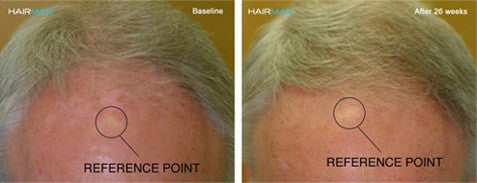Clinical Research Results
MORE CLINICAL STUDIES THAN ANY LASER HAIR GROWTH DEVICE.
HairMax has invested in more clinical studies on light energy for hair growth than any other company to date. Seven clinical studies with 460 men and women have been completed on HairMax Laser devices. These clinical studies were conducted at top medical research centers such as the Cleveland Clinic, the University of Miami and University of Minnesota and have resulted in 7 FDA 510(k) Clearances. The studies were designed to support 510(k) submissions to the FDA and were approved by an IRB (Independent Review Board) and complied with GCP (Good Clinical Practices) guidelines and monitored by a CRO (Contract Research Organization).

(May not represent typical results you may experience)
- Six of these studies were designed as multi-centered, double-blind and randomized control device.
- Designed to provide support of 510(k) submissions to the FDA – Major factor in granting of Clearances
- Approved by an IRB (Independent Review Board)
- Complied with GCP (Good Clinical Practices) guidelines
- Monitored by a CRO (Contract Research Organization).
CLINICAL STUDIES
The clinical studies included males & females between the ages of 25-60 yrs. with a diagnosis of Androgenetic Alopecia who had been experiencing active hair loss within the last 12 months. The inclusion criteria for males required a Norwood- Hamilton classification of IIa to V and Fitzpatrick skin types I to IV. Click for Classification Charts. The inclusion criteria for females required a Ludwig (Savin) classification of I-4, II-1, II-2, or frontal.
All subjects were randomized for laser hair loss treatment analysis. A biostatistician calculated the study to be of a proper size to gauge statistically significant results of hair growth and hair density. Subjects were instructed to use the laser hair growth treatment device three times per week on non-consecutive days, 10-15 minutes per treatment for a total of 26 weeks. Hair density measurements were performed at baseline, at 16 and 26 weeks. Additional clinical visits were scheduled to monitor the laser hair loss treatment progress and overall hair growth.
Clinical studies show that HairMax ®Laser hair growth treatment users experienced:
- Significant hair growth.
- Reversal of the thinning process.
- Increased density and fullness.
- Average hair count increase: 129 hairs per sq. in
- A substantial decrease in hair fallout.
- Increased rate of hair growth.
- More manageability of the hair.
- Overall better quality and condition of hair.

Mean Terminal Hair Count Changes From Baseline in Males
26 Weeks, Last Observation Carried Forward

Mean Terminal Hair Count Changes From Baseline in Females
26 Weeks, Last Observation Carried Forward
PUBLISHED ARTICLES
2014 – Results of 4 clinical studies in males and females
Published in April 2014 in the peer review medical journal, The American Journal of Clinical Dermatology. These 26 week studies were conducted at top medical research centers such as the Cleveland Clinic, the University of Miami and University of Minnesota
KEY CONCLUSIONS
- Statistically significant increase in terminal hair density (thickness)
- Higher percentage of LaserComb treated subjects reported overall improvement of hair loss condition and thickness and fullness of hair
- Increase in hair counts was comparable to short-term clinical trials of the other FDA cleared drugs.
- No serious side effects.
2014 – Results of a retrospective study to evaluate efficacy and safety as mono or concomitant therapy
Published in April 2014 in the peer review journal, the International Journal of Trichology.
KEY CONCLUSIONS
- 88% of patients showed significant improvement when LaserComb added to drug treatment
- 100% of all patients treated with the LaserComb after discontinuation of drug treatment showed significant improvement
- Improvement was observed as early as 3 months
- Efficacy sustained up to maximum observation time of 24 months.
- No adverse reactions reported
2009 – Results of key clinical study in males leading to first FDA Clearance
Published in May 2009 in the peer review journal, Clinical Drug Investigation. 26 week study comomparing lasercomb to sham device
KEY CONCLUSIONS
- Subjects in the lasercomb treatment group exhibited a significantly greater increase in mean terminal hair density than subjects in sham group
- Significant improvements in overall hair regrowth were demonstrated in terms of patients’ subjective self-assessment.
- No serious adverse events reported and no differences in adverse effects between lasercomb and sham device subjects
2003 – Results of hair regrowth and increased tensile strength
Published in November 2003 in the peer review journal, International Journal of Cosmetic Surgery and Aesthetic Dermatology
KEY CONCLUSIONS
- LaserComb stimulated hair growth
- Increased tensile strength of hair in men and women
- Effective in both vertex and temporal areas
HAIRMAX CLINICAL STUDIES
The photos shown below are of actual HairMax Laser device users, but are not intended to represent results everyone who uses the device will necessarily experience. Qualified subjects had global images recorded at each visit using a stereotactic device.

Filling in of hairline. Substantial increase in hair density. Overall improvement of hair quality.

Substantial increase in hair density. Overall improvement of hair quality.
CLINICAL STUDY NON-VELLUS HAIR DENSITY MACRO IMAGES
At baseline, a circle approximately 1 inch in diameter, positioned in the transition zone of the scalp, was identified as the site for hair clipping and tattooing. Within this site was the target area for the hair density evaluation during the laser hair growth treatment. Subjects were evaluated at baseline, week 8, week 16, and week 26. Digital images captured by FUJI S2 were taken of the target site within the clipped area following the site preparation. A 19-inch monitor was used for blinded evaluation.

Filling in of hairline. Substantial increase in hair density. Overall improvement of hair quality.

Substantial increase in hair density. Overall improvement of hair quality.